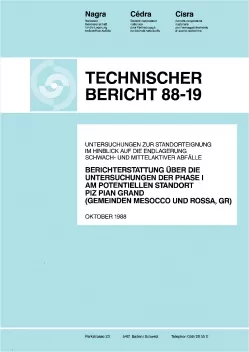
Technischer Bericht NTB 88-19
Untersuchungen zur Standorteignung im Hinblick auf die Endlagerung schwach- und mittelaktiver AbfälleBerichterstattung über die Untersuchungen der Phase 1 am potentiellen Standort Piz Pian Grand (Gemeinden Mesocco und Rossa, GR)
On 30th September 1985, the Federal Government granted Nagra permission to investigate the three potential sites Bois de la Glaive, Oberbauenstock and Piz Pian Grand with a view to assessing their suitability for disposal of low- and intermediate-level radioactive waste. This report summarises the investigations carried out at Piz Pian Grand, together with the results obtained during the course of the programme.
The first chapter discusses the key aspects of planning and performing the work and outlines the general objectives of the research. It also gives a brief time-schedule for the investigations.
The results of the geological investigations are detailed in chapter 2. Starting with an overview of existing data on the area, the report goes on to give as comprehensive as possible a picture of the geological and hydrogeological conditions found to exist on analysis of the investigation results. Detailed geological mapping was used to document the distribution of different rock types and the occurrence of structures formed by ductile and brittle deformation processes. From a lithological viewpoint, the mapping basically confirmed the distribution of rock types already known from earlier authors. Compared with earlier documentation, reconnaissance of the structural geology has resulted in greater emphasis being placed on the significance of faults (some of them with indications of neotectonic movements) and joints. The results of the surface mapping programme were complemented by analyses of core material from four shallow boreholes drilled from the Valbella-Spina free-surface flow tunnel. Geophysical measurements in the boreholes also provided additional data on physical parameters of the rock mass, thus rounding off the picture of local geological conditions.
Knowledge of the geological situation was further widened by analysing the geophysical investigations carried out in the free-surface flow tunnel. In two separate measuring campaigns profiles of the electrical resistivity of the rock, natural gamma radiations and seismic velocities (compression- and shear-waves) were recorded. The data obtained confirmed the existence of a zone of very low water flow; in addition it allowed a zonation along the tunnel profile to be derived; this correlated well with geological measurements made during construction of the tunnel and with geological conditions at the surface.
The hydrogeological conditions in the Piz Pian Grand area were investigated by a series of hydraulic tests carried out in the four boreholes drilled from the free-surface flow tunnel. Very low permeabilities (below 10-11 m/s on average) were found for the schists and schistose gneisses encountered in the boreholes. The low permeabilities also mean that the pressures measured during the tests have only a limited application to larger rock volumes. The pressures are also influenced to a large extent by drainage to the tunnel.
The surface hydrogeology programme involved a survey of documented springs, regular measurements of relevant parameters and hydrochemical analyses of selected waters at the surface and in the tunnel. The objectives of the programme were two-fold; firstly it serves as instrument in any precautionary steps taken to preserve testimony and, secondly, it provides an initial database for describing the hydrogeological situation.
Interpretation of the results from the geophysical, geological and hydrogeological investigations allowed a first general description of the conditions encountered in the potential host rock, with particular reference to the study of water flow systems.
The modelling studies and a provisional engineering concept for a potential repository for low- and intermediate-level waste are described in chapter 3. The long-term safety of a potential repository at Piz Pian Grand was first analysed in 1985/86, the data acquired in the present investigations being used to update the existing safety analysis. There was no indication that the repository would fail to provide the level of safety required.
The hydrodynamic model calculations carried out before the commencement of the work documented in this report are still valid as there proved to be no contradiction between the data acquired in the field and the dataset used in the model.
The fourth and final chapter summarises all the aforementioned results. It can be concluded that there are no grounds for ruling out Piz Pian Grand as a potential site. The data required for a more detailed assessment of the suitability of the area for low and intermediate-level waste disposal can only be obtained by constructing an exploratory drift.
